Chapter LXXXII: Bellum et Pax (18 July 544/210 BC to 31 July 546/208 BC)
Chapter LXXXII: Bellum et Pax
(18 July 544/210 BC to 31 July 546/208 BC)

(18 July 544/210 BC to 31 July 546/208 BC)

I hope this Google translated word construction for ‘War and Peace’ is correct: if not, Latin scholars please let me know and I will adjust it. Edit:thanks to @GulMacet and @HistoryDude for suggesting and explaining the more applicable ‘Bellum et Pax‘ rather than Belli et Pacis. 
§§§§§§§
Part I – Politics and Religion
Part I – Politics and Religion
With the Great Eastern War now in its fifth year, the Roman army was considerably smaller than it had been at the start, after heavy casualties and the consolidation of many cohorts in the last few years – in large part to minimise the effects of attrition and ensure surviving cohorts could be reinforced from the dwindling manpower reserve.
On 18 July 544 AUC, the Roman army fielded 147 cohorts (both regular and auxiliary), with another two in training, against a maximum notional ‘troop support limit’ of 225 cohorts. This represented a net loss (after any new additions during that time) of about 60 cohorts in four and years and four months throughout the Republic. Manpower reserves were at net total (available men less replacements needed) of 35,000. In terms of total troops fielded, there were around 185,000 men in the field, training or reserve, with 14,600 replacements required.

Aside from the main war front, the risk of revolts was greatest in the four most recently acquired provinces – three in Greece (taken from Macedon in a separate settlement) and one (Lemovices) in Gaul. The rest were either under occupation in the current war, or scattered around Gaul, Hispania and Illyria – and funnily enough in Roma itself [the proles must have been restless – I only noticed this as I started writing this up].

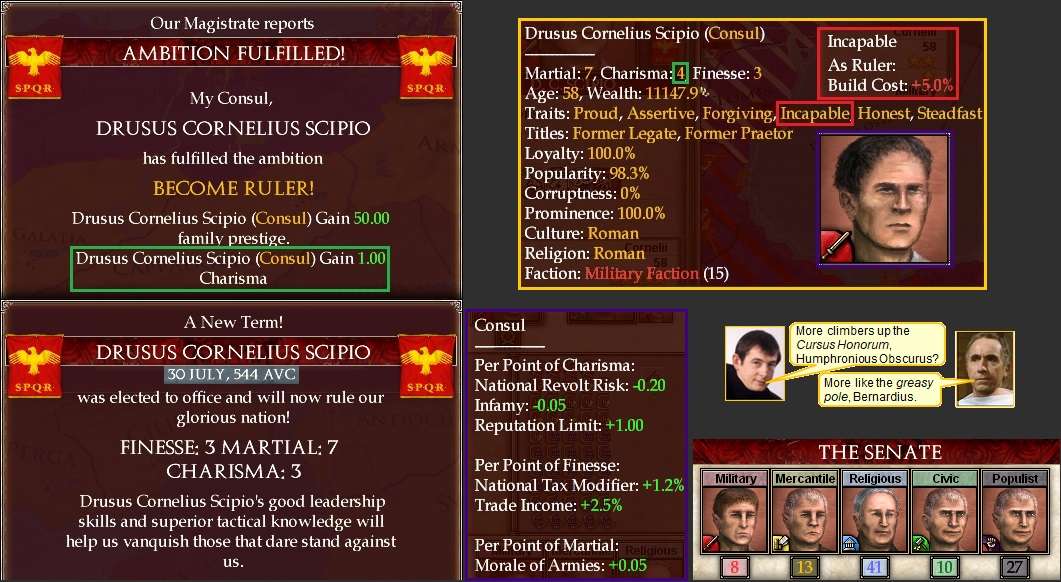
“He has many redeeming qualities Bernardius,” the senior civil servant observed. “Alas, he is not a capable administrator and will no doubt get in the way of good government. But it could be a lot worse.”
Scipio soon arrived for his brief as incoming Consul.
“Ah, Humphronius Obscurus, I hope we will have a fruitful partnership over the next two years.”
“Yes, Consul, may the Gods make it so.”
Of course, exactly what would constitute a ‘fruitful partnership’ was likely a very different thing in each man’s mind. In Rome, it was ever thus.
Over the next two years, the Gods too had a typically ambivalent view of fruitful partnerships with the leaders and people of the Republic.

§§§§§§§
Part II – The East
July-December 544
On 18 July, the siege of Rhodes was almost finished [100%], that of Paphlagonia about half-way through [50%] and Pontus barely begun [0%]. T.F. Gurges was en route from the recently successful siege of Crete to Greece, getting in position to confront the disloyal Theodoric Geroldid, who commanded 6,000 troops in Achaea and posed a revolt risk.
By mid-September, the sieges were progressing well [Paphlagonia now also 100%, Pontus 38%], and Legio II (the loyal Huneric Geroldid, 7,000 men) was in Bithynia and moving further east. Then on 16 September, Legio VI (Q.M. Vitulus) arrived in Pontus but – with attrition now too high there (decimation - ie 10%) – was moved onto Trapezus, to put it under siege, leaving Legio IV to besiege the Pontic capital.

Over in the east, Zagreid finished his retreat to Trapezus (well ahead of Vitulus’ arrival there) on 28 September and began heading south to Armenia with his 21 regiments (of unknown strength). More good news followed for Rome on 7 October, with the fall of Paphlagonia to Q.F. Flaccus’ Legio V after a 343 day siege. Flaccus was ordered north-east to Amisus with his five under-strength cohorts (3,70 men) to put it under siege as well. Then just ten days later, Rhodes fell after a 229 day siege.
The Roman plan continued methodically, with Flaccus arriving in Amisus on 31 October and wiping out a 1,000 man regiment there in four days for the loss of only eight men, after which he prepared his siege lines. In Rhodes, M.C. Dentatus’ 3,000 man detachment was embarked from Rhodes and ferried back to Greece, where he would reinforce Gurges and allow the disobedient T. Geroldid to be confronted. Then a day later, Legio VI arrived in Trapezus, finding Zagreid gone and just a 1,000 man Pontic regiment encamped. They were wiped out for no loss the day Vitulus arrived, allowing the siege to commence straight away.
A little surprisingly, Rhoxolani allowed Pontus to escape with a white peace agreement on 18 November, even though they had been occupying three Pontic provinces. But this left more for Rome to potentially occupy, so Legio II was ordered back to Tomis to see if they could put that in the bag as well.
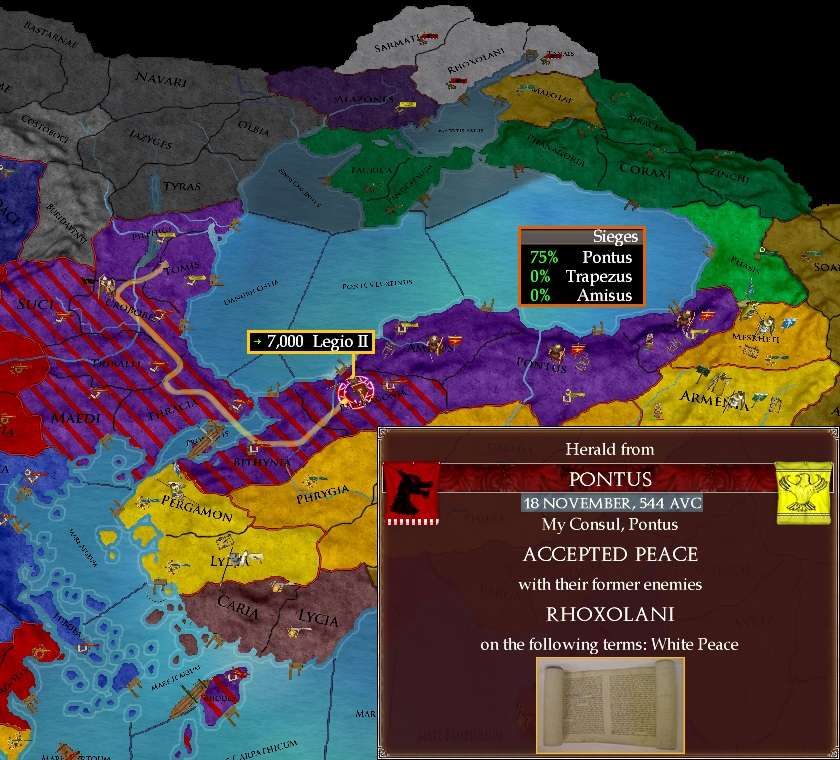
But in early December, the situation in Asia began to heat up. Zagreid was spotted with his 2nd Stratos (strength and morale unknown) in Armenia, making for Pontus. Attrition had reduced Legio IV to a little less than half its paper strength (21 cohorts, 10,354 men). Vitulus was ordered to break the siege of Trapezus (where no progress had yet been made) and head back to Pontus, though they would be due to arrive about four weeks after Zagreid. With the siege of Pontus well-progressed, the Romans did not want to let it go without a fight.

As the latest clash in the East approached, Gurges was sent into T. Geroldid’s camp to arrest the recalcitrant legate. As it happened, Geroldid did not resist and was marched off to prison. All the troops present were merged into Gurges Legio VIII. There was a little grumbling among influential Romans of the ‘tyranny of the state’. After all Geroldid had not actually revolted at this stage (he was technically just refusing to relinquish his command), but this would wear off in time.
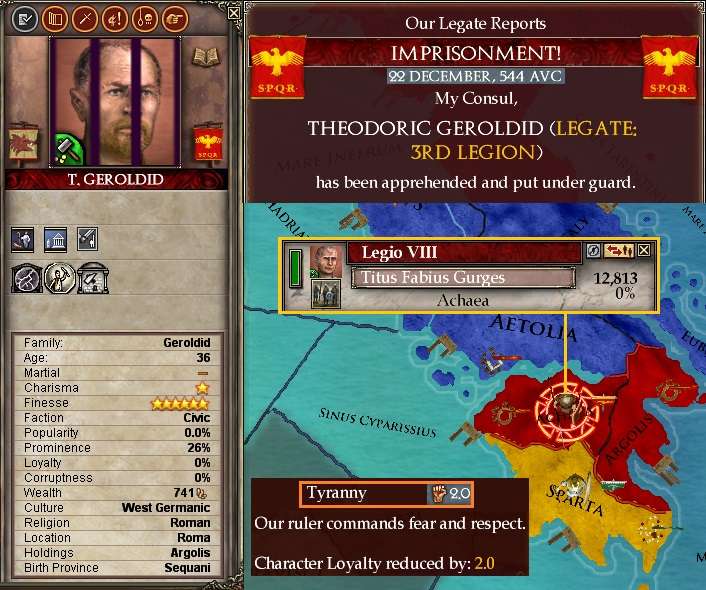
“Very prudent, Consul,” murmured an approving Humphronius when Scipio let him know what was afoot. High praise indeed!
“He deserves a triumph after all his good work in this war, even if his loyalty is not in immediate doubt, Humphronius. Please Make the arrangements.”
“Yes, Consul.”
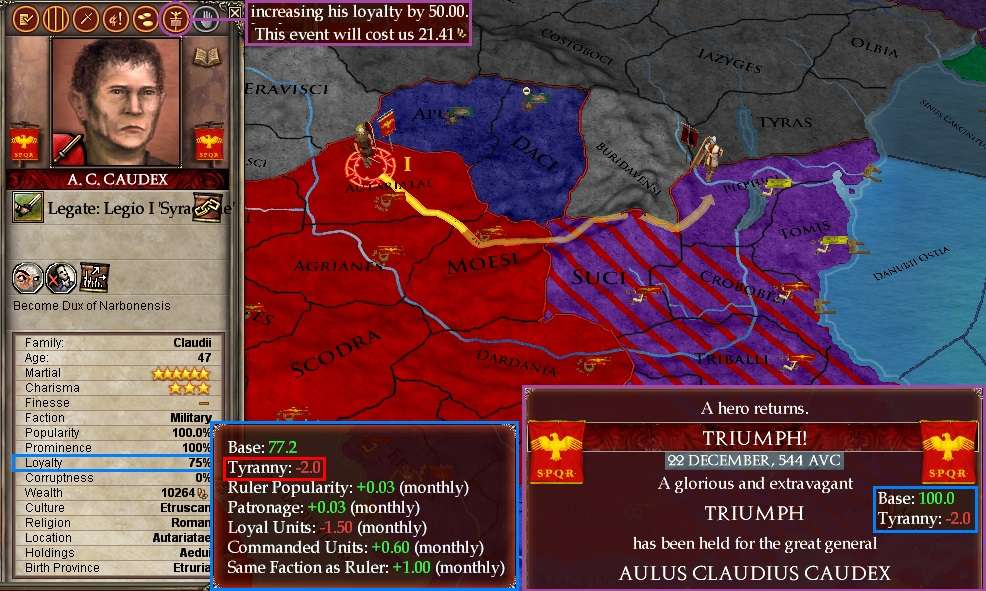


§§§§§§§
January-December 545
To make matters worse, H. Geroldid’s Legio II was attacked in Bithynia on 20 January 545 AUC as it made its was north to Thrace by a similarly sized Pontic force approaching from Phrygia. The opening exchanges were fierce though even. The following day, Vitulus (Legio VI) attacked Zagreid in Pontus, with Legio V arriving the day after on 22 January. The result was only somewhat less disastrous than the previous battle, with Vitulus significantly outnumbered, attacking over a river, and his tactics no match for Zagreid, who was clearly ‘back in form’. This battle too was called off as soon as it could be, with another 3,100 legionaries lost, though at least they had put up more of a fight than their colleagues had the month before.


The three bedraggled legions fleeing from Pontus were now suffering bad attrition [10% per month] on top of the grievous losses they had taken (around 15,000 men left from approximately 40 cohorts). More would die on the march back to Thracia.
The following day, the Senate declared the previous mission (the always highly improbable taking of Kirkuk) to have failed. As the incumbent Consul, Scipio’s Military faction wore the political cost of this failure. Once again, the Senate’s eyes turned to Macedonia, which should prove a far more practical and attractive proposition in due course (with 15 years allowed for it). But there were still a few years left on the treaty with Macedon to run, and it would likely take longer than that before Roman manpower had rebuilt to an acceptable level.
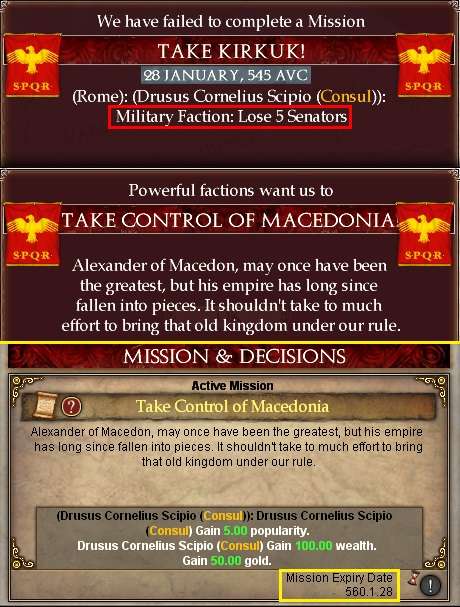

With discontent running high in the new Greek provinces, a revolt broke out in Paeonia on 2 August 545. The 5,000 rebels were defeated and dispersed for the loss of 183 soldiers from Legio II, who were by then on garrison duty there. Nine days later, barbarian stragglers arrived in Liburni (fleeing from an earlier defeat by the Massilians as they passed through Histri). Legio IV (back up to around 10,200 men in 16 cohorts under Licinus) was sent from Dardania to intercept them before they did any appreciable damage.
Yet another revolt broke out in Paeonia on 3 November 545, this time taking a week and 361 Roman casualties for Geroldid and Legio II to despatch the 5,000 rebels. By 18 December, recruiting began again in Illyria, with two principes (heavy infantry) and one equites (cavalry) regular cohorts put into training. This gradual build-up would continue in the coming months, to replace lost auxiliary troops and eventually replenish the five eastern legions to between 16-20 or more cohorts each.
On 24 December, Licinus took out his frustrations on the Veneti tribe in Liburni, taking three days to wipe out all 3,516 of their warriors, pocketing 0.49 gold and 4,000 slaves, for the loss of 492 of his by then 14,500 troops. [The Veneti leader had 9 martial skill and got a 7 v 5 die roll, so it cost more than it might.]
§§§§§§§
January-July 546
Things remained quiet in the East over the coming months, until news came through in March 546 that the Seleucid rebellion had finally collapsed after a six year civil war. At that point, Parthia had taken a province back off the Seleucids, but the Greeks would now be able to give their undivided attention to the Parthian threat. Of the (still extant) Eastern Pact, Macedon remained rich and stable but short of men; Pontus was broke and only barely stable, but had a large manpower reserve; and the Seleucids lacked stability, but had reasonable financial and manpower reserves – and an enormous research capacity.
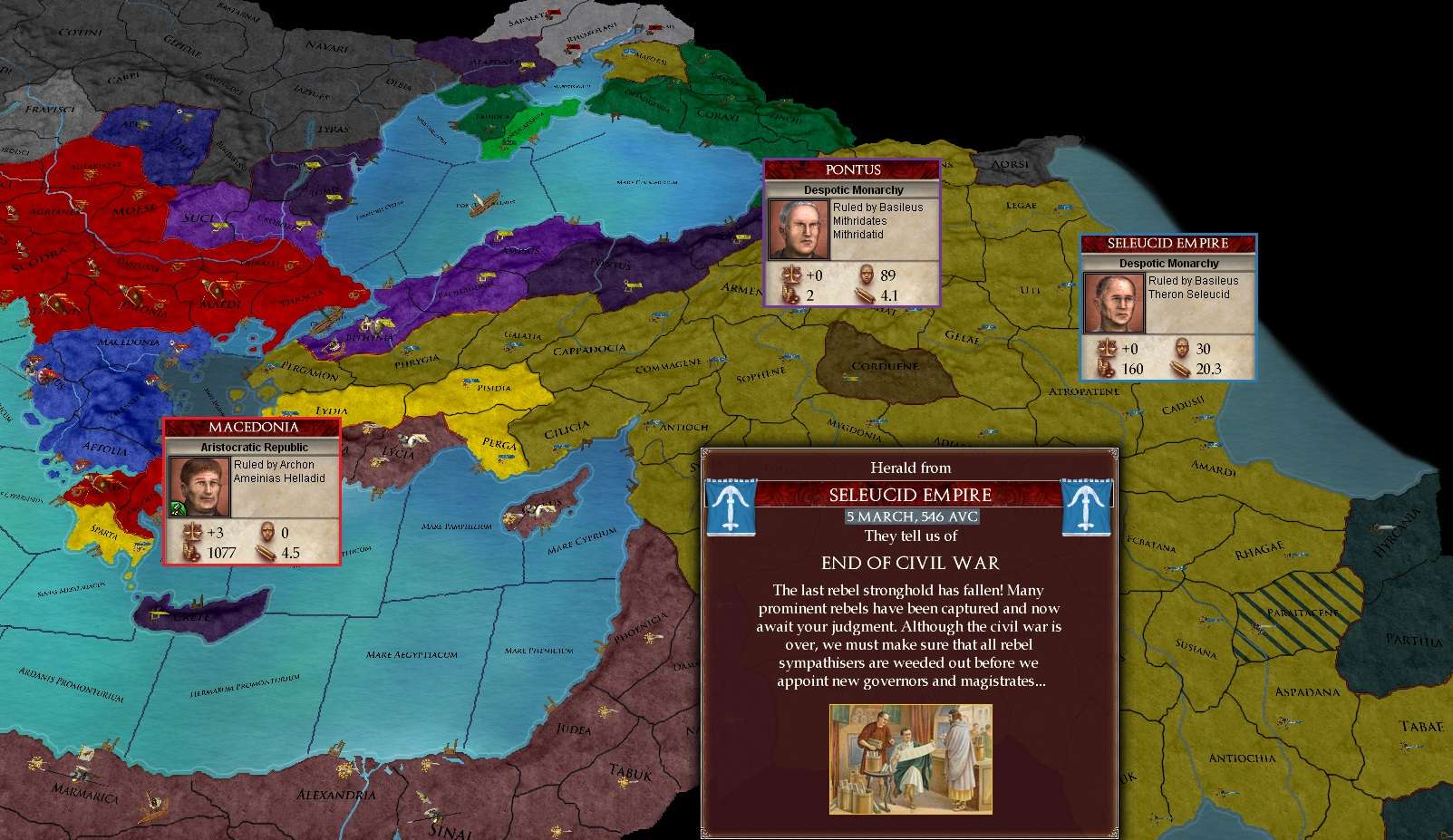
§§§§§§§
Part III – The West
Part III – The West
As the war first meandered on in the east until the end of 544, before hotting up again in December, barbarians and revolting locals kept the Western legions busy. One campaign was against the Hermunduri tribe, a large group of barbarians (with 19,600 warriors at that time under Catualda Andicid, [Martial 6]) who had invaded Raetia in mid-544 AUC. Legio XI (S.S. Paterculus, [Martial 8]) had been sent with 16 cohorts (at around 14,000 strength to start with) to evict them. He would fight five battles against them between April 544 and August 545: one in Raetia and the rest in Gallia Cisalpina before they were wiped out. Rome lost a total of 5,647 men in killing 17,519 barbarians, taking 1.51 in gold and 18,000 slaves.
Overlapping with this campaign, the Senones tribe rebelled in Gallia Cisalpina, requiring Legio XI to deal with them in between battle against the Hermunduri between January and April 545. In two battles in Gallia Cisalpina, 3,920 rebels were killed for the loss of 508 legionaries, with 4,000 slaves taken when these barbarian rebels were finally defeated.
Over in Gaul, malcontents rebelled in Lemovices in December 544, put down by Legio III (H. Magoid, 12 cohorts) in a rather bloody two-week battle, 1,646 Romans died killing 1,703 of 5,000 lightly armed rebels [Roman (2)1 (-1 for a river) v 7 Rebel initial die roll].
In Hispania, Legio X (M.C. Scipio, 10,368 men) fought a successful campaign against the Luggones tribe (15,434 warriors) in five battle in from September 544 through to April 545. In the fighting, Scipio lost only 448 men in killing 15,234 of the barbarians, taking 14,000 slaves into captivity after their final defeat. In between battles, colonists were sent into Saguntum on 23 November 544, establishing a new Roman settlement on 24 March 545. Naturally, construction of a stockade was begun immediately.

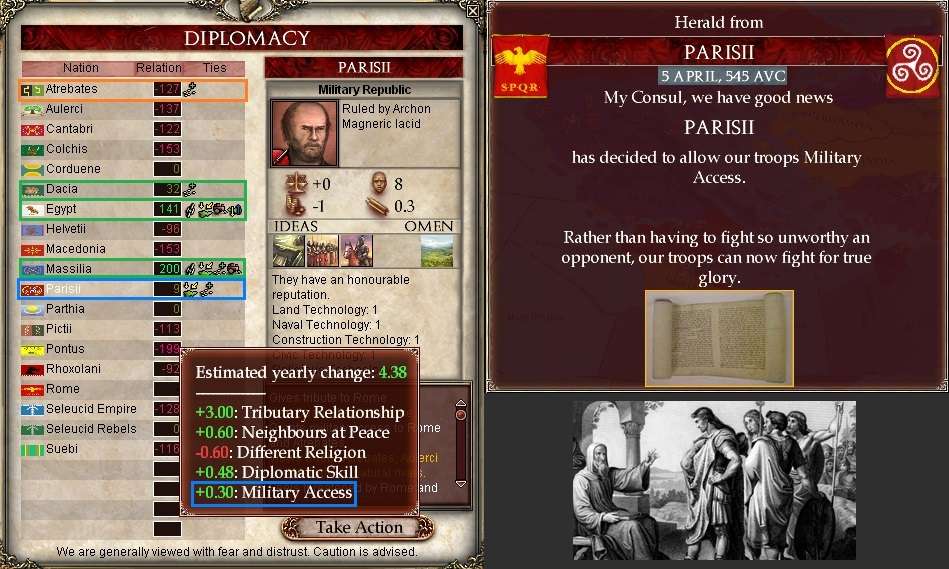
A revolt in Cadurci by the rebellious Orgonomesci tribe broke out on 12 September 545, but Legio III was in garrison there at the time. Magoid snuffed out the uprising in a single day, putting all 2,000 rebelling barbarians to the sword, taking 0.34 gold and sending 2,000 camp followers into slavery, for the loss of five soldiers.
To the north of Italia, Rome had its covetous eyes on two potential new provinces: on 12 September (the day the rebels were put down in Cadurci) colonists were sent to Vindelicia to bring it into the Republic. At the same time, Paterculus was put on notice to be ready to attack the Helvetii, directly north of Gallia Cisalpina (where Legio XI was currently recovering in garrison quarters after the recent barbarian campaigns) and west of Vindelicia.
The declaration of war came against the Helvetii on 29 September. The envoy, A. Magoid (considered by the Establishment to be an expendable Populist troublemaker) delivered the declaration. Unfortunately for him, the reply came back to Roma in carved box: the poor man's head!

“Yes, Consul,” mumbled a rather shocked Bernardius, who had just delivered the report of the execution (not the head itself, of course) to the Consul.
In the battle for Helvetii, the local commander put up a very strong fight, losing just 274 of 2,000 Helvetii warriors to 661 of Paterculus' 14,000 men. But they were forced to retreat and Paterculus began his siege on 13 January. The same day, word came that the colony in Vindelicia had been established and a stockade begun.
In Hispania, M.C. Scipio had his reinforcements ready: war was declared on the Cantabri on 22 January 546 and Legio X marched north to Vaccaei.
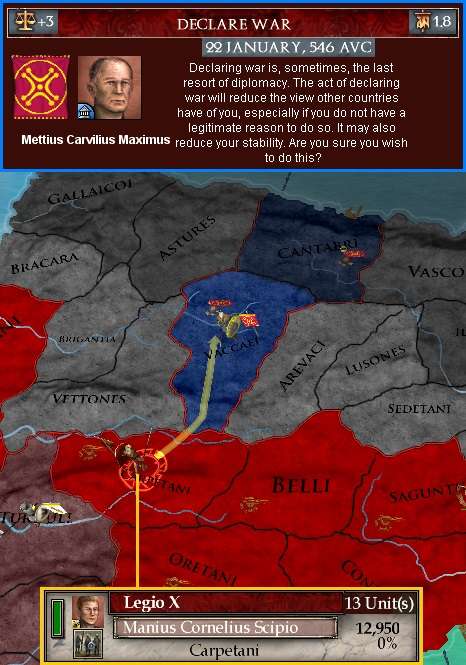
Once the Helvetii finished their retreat to Lingones on 15 March, they made for Roman Sequani rather than their heavily occupied homeland. Paterculus broke off a detachment of five cohorts to deal with them, while the rest of Legio XI stayed to conduct the siege of Helvetii. But before the Helvetii could get out of Lingones, on 3 April they stirred up a barbarian uprising 10,000 Tarbelli tribesmen. When this happened, Paterculus had no idea how the fateful Tarbelli invasion would finally become. The Helvetii were soon defeated and headed north to Remi, while the Tarbelli made straight for Helvetii. And Paterculus recalled the detachment to re-form Legio XI in full, as Sequani was no longer under direct threat.
As Paterculus waited for the Tarbelli to arrive in Helvetii, Vaccaei fell to Scipio on 2 May. The same day, the main Cantabrian army (five regiments) was moving to the east through Arevaci; they stirred up the Lusones tribe (two regiments) and the two sides started fighting. At that point, with the barbarian and revolt threat diminishing in Africa, Legio VII was split up in Mauretania. M.V. Maximus kept 11 cohorts, while a re-formed Legio V was allocated four cohorts under the venerable Q.F. Flaccus, who started marching up towards Oretani, across the Pillars of Hercules.
At the same time, in Vaccaei Legio X split off four cohorts, who would head south to eventually join up with Flaccus to secure the Hispanian holdings against any Cantabrian or barbarian attacks. Scipio kept nine cohorts to complete the conquest of Cantabri.
Earlier, Legio III had started across from Cadurci in southern Gaul to help with the invasion of Cantabri, but was turned around in (barbarian) Aquitani when the troops were sent up from Mauretania. But before they could return to Cadurci, they stirred up yet another new barbarian tribe: the Vadiniensi, who fielded 9,000 men and attacked Legio III in Aquitani on 1 June 546. Magoid defeated them by 14 June, losing 334 men while killing 3,407 barbarians. But the Vadiniensi would be back, so Legio III would have to stay encamped in southern Gaul for some months yet.
At exactly the same time (1-14 June), Paterculus [Martial 8] was fighting the Tarbelli in Helvetii. It turned out that the chief of the Tarbelli warband, Drappes Marganid, was something of a military prodigy [Martial 9], meaning they would be a difficult foe to defeat without absorbing comparatively heavy casualties. But the 9,400 warriors Marganid brought to Helvetii were indeed defeated, the Romans losing 755 soldiers in killing 2,165 Tarbelli warriors.
Given the two battles going on simultaneously and previous large scale barbarian invasions of Gaul and northern Italia, two more regular cohorts began training in Gaul on 1 June – one of principes, another of archers. In Hispania, Scipio’s cut-down Legio X arrived in Cantabri, slaughtered a single regiment guarding it for the loss of five legionaries, and began a siege. Then in Africa, the former Consul M.V. Maximus shuffled off his mortal coil on 14 June, leaving Legio VII without a legate. The only available general was basically an incompetent, disloyal, incapacitated Populist. So the post was left open, in the forlorn hope the Senate might appoint someone good to command it.
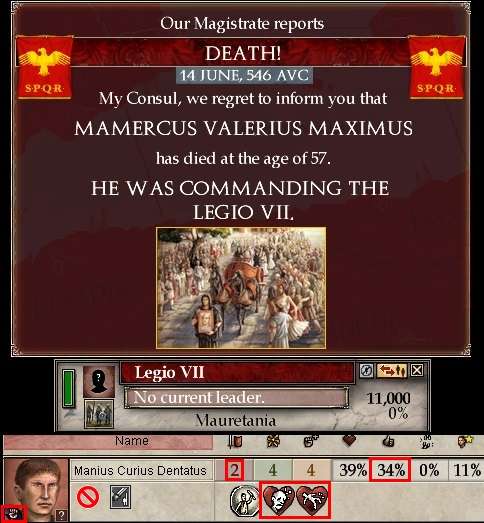
Only one pirate fleet had emerged over the two-year period, destroyed in Mare Gallicum on 4 March 545.
So stood the situation in the West, as the elections of 546 came due.
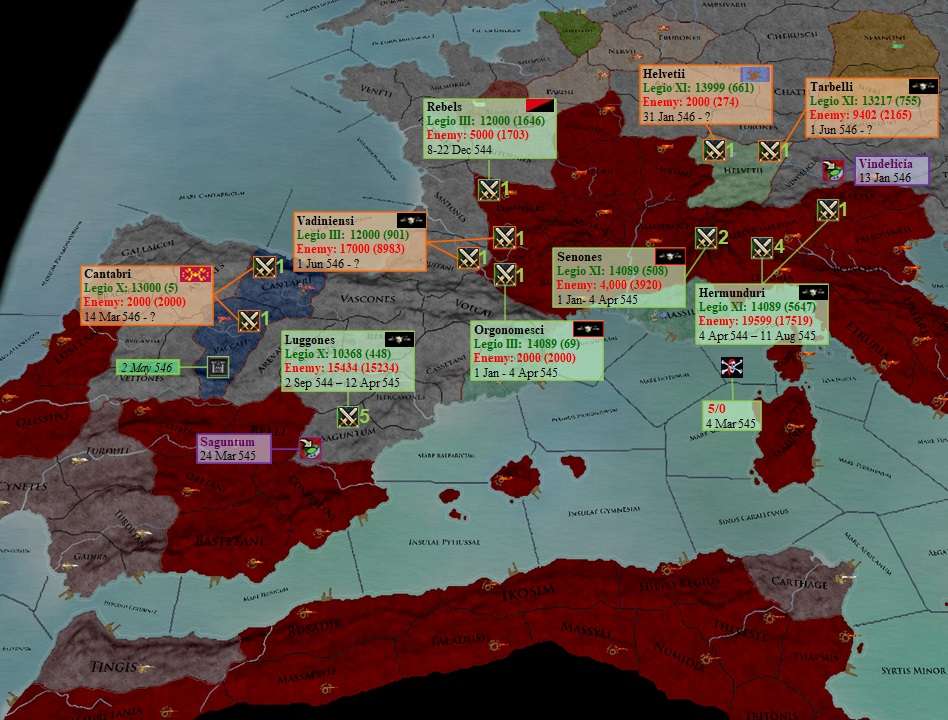
Campaigns in the West: 18 July 544 to 31 July 546.
[Note: This map summarises the campaigns of 544-46 AUC described above, rather than individual battles. Green boxes denote completed campaigns and sieges won by Rome; orange are continuing wars or campaigns and purple new colonies. Numbers next to battle icons denote how many were fought in that location in that campaign. A red border around a barbarian incon means it was a local barbarian rebellion rather than an invasion, or a rising by nationalist malcontents.]
§§§§§§§
Part IV – Provincial Developments and Manpower
Part IV – Provincial Developments and Manpower
In Illyria, a previously commissioned stockade was completed in the new border province of Breuci in August 544. Raetia converted to the Roman state religion in September 544 – a sign the Roman patrimony was becoming more homogeneous. Cadurci’s stockade was completed in February 545 – a timely addition begun around a year before. And the following month, two long-running irrigation projects were finished in Bononia and Campania. The next good news to come from Hispania was that Carpetani had been absorbed: both religiously and culturally, becoming a fully fledged Roman province.
The Governor of Mauretania then funded a temple building in Rusadir in September 545, while Saguntum’s stockade was completed in March 546. In mid-May 546, the Romanisation of Hispania continued, with the full absorption of Contestani, whereupon a temple was begun (given the absorption included a conversion to the Roman state religion). And with Roman religious power waning again, further temple builds were begun in Raetia, Belli and Carpetani (each costing 51.75 gold each and taking about a year to complete).
In November 545, Roman reserve manpower stood at 35,999 and 126,211 troops were serving in the legions: so a net troop strength of 162,210 with monthly recruit accrual of 1,077 per month. By July 546, manpower was at 28,921, with 138,489 troops in the legions – a net strength of 167,410. So about 5,000 more troops than two years before – new recruitment against casualties in the last months of the Eastern War and in barbarian campaigns, revolts and conquests, mainly in the West.
§§§§§§§
Finis
Finis
Last edited:
- 2

